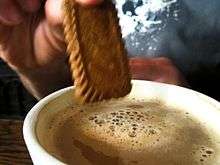Dunking (biscuit)

To dunk or to dip a biscuit or some other food means to submerge it into a beverage, especially tea, coffee, or milk. Dunking releases more flavour from confections by dissolving the sugars,[1] while also softening their texture. Dunking can be used to melt chocolate on biscuits to create a richer flavour.
Dunking is a popular way of enjoying biscuits in many countries. A popular form of dunking in Australia is the "Tim Tam Slam", also known as 'tea sucking'.[2] The physics of dunking is driven by the porosity of the biscuit and the surface tension of the beverage. A biscuit is porous and, when dunked, capillary action draws the liquid into the interstices between the crumbs.[3]
Dunking is first reported with ancient Romans softening their hard unleavened wafers (in Latin "bis coctum": twice baked) in wine.[3] Modern day dunking has its roots in naval history when, in the 16th century, biscuits known as "hard tack" were on board Royal Navy ships, which were so hard that the British sailors would dunk them in beer in order to soften them up.[4] The most popular biscuit to dunk in tea in the United Kingdom is McVitie's chocolate digestive.[5] In the US, Oreos are frequently dunked in milk, while the Dunkin' Donuts franchise is named for the practice of dunking doughnuts into coffee. In South Africa and in India, rusks are a popular food for dunking in both tea and coffee. In the Netherlands, stroopwaffels are commonly dunked in tea or coffee, often after having been set on above the hot drink for a few minutes to melt the caramel inside.
Dunking is also used as a slang term for intinction: the Eucharistic practice of partly dipping the consecrated bread, or host, into the consecrated wine, by the officiant before distributing.
Biscuit dunking, etiquette and style
While modern day dunking has its origins in 16th century naval history, it wasn't until the 19th century and the emergence of afternoon tea in the early Victorian era that Britain began to regard biscuits as something dunked in tea; a British custom that was later exported around the globe.[6] Different cultures have different attitudes toward biscuit dunking. Historically in British high society, dunking was frowned upon and generally seen as children's or working class' fashion. Opinion has changed over the years, with one themed tea room outlawing dunking on its premises as an example of out-dated etiquette[7] while the Michelin starred English restaurateur Heston Blumenthal publicly advocates the act.[8]
Biscuit dunking and science
Physicist Len Fisher of the University of Bristol presented some light-hearted discussion of dunking on "National Biscuit Dunking Day" in the UK, as part of an attempt to make physics accessible. Fisher appeared to be somewhat taken aback by the large amount of media attention, ascribing it to a "hunger for accessible science". Fisher also described his astonishment at journalists' interest in one equation used in the field: Washburn's equation, which describes capillary flow in porous materials. Writing in Nature, he says "the equation was published in almost every major UK newspaper. The journalists who published it took great care to get it right, some telephoning several times to check".[9][10]
Cultural references
In Marcel Proust's novel In Search of Lost Time one of the narrator's childhood memories sets in while tasting a madeleine dunked in tea. The soft, spongy consistency of the madeleine could seem like an odd choice as dunking is more common with crisp baked products, such as biscuits. In fact, draft versions of Proust's manuscript reveal that the author initially had the narrator dunk a piece of toasted bread.[11]
In the British comedy-drama film The Best Exotic Marigold Hotel, Evelyn Greenslade (Judi Dench), one of the main characters, explains dunking to her new employer during an interview whilst drinking Builder's tea. Evelyn, quite poetically describes it as "lowering the biscuit into the tea and letting it soak in there and trying to calculate the exact moment before the biscuit dissolves, when you whip it up into your mouth and enjoy the blissful union of biscuits and tea combined."[12]
References
- ↑ Lee, Laura. The Pocket Encyclopedia of Aggravation. New York: Black Dog & Leventhal, 2001.
- ↑ "Tea-sucking record attempt". Croydon Guardian. Retrieved 30 January 2014.
- 1 2 3 4 "Biscuit Dunking Physics". Australian Broadcasting Company. Retrieved 30 January 2014.
- ↑ R G Grant (2010). "Battle at Sea: 3000 years of naval warfare". p. 306. Dorling Kindersley Ltd
- ↑ "Chocolate digestive is nation's favourite dunking biscuit". The Telegraph. May 2, 2009.
- ↑ "Crunch time: why Britain loves a good biscuit". The Guardian. Retrieved 30 December 2014
- ↑ http://www.timesonline.co.uk/tol/life_and_style/food_and_drink/article2217991.ece
- ↑ "Heston Blumenthal: biscuits really do taste better after dunking". The Telegraph.
- ↑ quotes from Nature 397, 469; 1999)
- ↑ Steve Connor (25 November 1998). "Biscuit dunking perfected". The Independent.
- ↑ L'Objet | Karambolage | Européens | fr – ARTE
- ↑ "The Best Exotic Marigold Hotel (2011) – Quotes – IMDb". imdb.com.
External links
-
 Media related to Food dunking at Wikimedia Commons
Media related to Food dunking at Wikimedia Commons - dunk debunked! Cooled cuppa with full-fat milk plus a Rich Tea biscuit makes perfect dip, finds scientific investigation